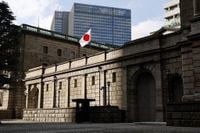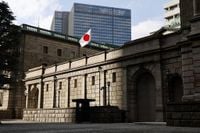Japan’s economic landscape is showing signs of subtle yet meaningful change, as the latest Bank of Japan (BOJ) quarterly tankan survey reveals a steady uptick in optimism among the nation’s large manufacturers. Released on October 1, 2025, this closely watched survey—often seen as a bellwether for the country’s broader economic trajectory—showed that sentiment among major manufacturers improved for the second consecutive quarter. The key diffusion index, which measures the difference between companies foreseeing good business conditions and those feeling pessimistic, rose by one point to plus 14 compared to the previous survey in June.
For those familiar with Japan’s economic rhythms, the tankan’s findings are more than just numbers on a chart. They are a reflection of how the nation’s biggest industrial players perceive the months ahead. The last time the tankan for large manufacturers dipped was in March 2025, when it fell to plus 12—its first drop in a year, according to the Associated Press. Now, with the index inching back up, there’s a cautious sense of recovery in the air.
But it’s not just manufacturers who are being measured. The tankan also tracks sentiment among large non-manufacturers, a category that includes businesses in sectors like retail, finance, and services. In the latest survey, their outlook remained unchanged at a robust plus 34. This stability hints at a broader resilience in Japan’s domestic economy, even as external forces continue to buffet the archipelago.
One of those external forces has been the ongoing saga of tariffs between Japan and the United States. Earlier this year, Japanese exporters faced a daunting 25% tariff on auto imports to the U.S.—a major blow for one of the country’s flagship industries. However, a new agreement reached in July 2025 brought a measure of relief: most goods exported to the U.S. would now face a reduced tariff of 15%. While not a panacea, the deal has certainly provided some breathing room for Japanese automakers and other exporters, as well as a welcome sense of policy certainty—at least for the time being.
Yet, as the Associated Press notes, higher tariffs are still squeezing profits, wages, investment, and spending across many industries. The pain hasn’t been entirely alleviated. Kei Fujimoto, a senior economist at SuMi Trust, offered a measured assessment: “We do not believe inbound-related demand from tourists has peaked. The number of tourists visiting Japan continues to show an upward trend.” That’s good news, since inbound tourism has become an increasingly important pillar of Japan’s economic vitality, helping to offset some of the challenges posed by trade friction and sluggish domestic demand.
Tourism’s ongoing ascent is more than just a statistical quirk. In the wake of the pandemic’s travel restrictions, Japan has seen a remarkable resurgence in foreign visitors, drawn by everything from cherry blossoms to cutting-edge technology. The influx of tourists has boosted demand for hotels, restaurants, and cultural attractions, injecting fresh energy into the country’s service sector. According to the tankan, this inbound-related demand is far from peaking, suggesting that tourism could remain a bright spot for some time.
Amid these shifting economic currents, the Bank of Japan faces a delicate balancing act. For years, the central bank has kept interest rates near zero in an effort to stimulate consumer spending and business investment, hoping to banish the specter of deflation that haunted Japan for decades. But now, with prices rising above the BOJ’s target range of about 2%, the calculus is changing. The tankan survey found that the average inflation outlook for one year ahead remained steady at 2.4%, signaling that companies expect price pressures to persist.
Earlier in 2025, the BOJ made a notable move by raising its benchmark interest rate from 0.1% to 0.5%. This marked a significant shift in policy, reflecting growing confidence that the economy could withstand higher borrowing costs. Still, analysts are divided on when the next rate hike might come. Some predict that the BOJ could act as soon as its upcoming meeting later this month, while others believe the central bank will wait for more definitive signs of sustained growth and inflation.
Why all the fuss over a single percentage point in the tankan? For policymakers and market watchers, these incremental changes offer vital clues about the health of Japan’s export-driven economy. A rising diffusion index suggests that manufacturers are feeling more upbeat about their prospects, which could translate into higher investment, more hiring, and—ultimately—stronger growth. Conversely, a dip in sentiment might signal trouble ahead, prompting the BOJ to adjust its policies accordingly.
The tariff agreement with the U.S. has been a major factor shaping business sentiment. While the 15% tariff is still a burden, it’s a marked improvement over the initial 25% rate that had many Japanese automakers and electronics firms worried. The deal has also introduced a degree of stability into what had been a highly unpredictable trade environment. For now, at least, companies can plan with a bit more confidence, knowing that the rules of the game aren’t likely to change overnight.
But not everyone is breathing easy. Some industry leaders remain wary of the long-term impact of higher tariffs on profits and competitiveness. Even with the reduction, the cost of exporting to the world’s largest market remains significant. Many firms are looking for ways to adapt—whether by shifting production overseas, investing in new technologies, or exploring alternative markets in Asia and beyond.
At the same time, the BOJ’s next moves are being watched with keen interest both at home and abroad. After years of ultra-loose monetary policy, even a modest rate hike sends ripples through global financial markets. Investors are eager for any hint of the central bank’s intentions, and the tankan’s findings are likely to weigh heavily on their calculations.
For ordinary Japanese consumers, the story is a bit more complicated. While rising business sentiment and robust tourism are positive signs, higher prices and interest rates could put a damper on household budgets. The BOJ’s challenge is to chart a course that supports growth without fueling runaway inflation—a task easier said than done.
Looking ahead, much will depend on how global economic conditions evolve. Trade tensions, currency fluctuations, and geopolitical uncertainties all have the potential to disrupt Japan’s fragile recovery. But for now, the tankan’s latest reading offers a measure of reassurance: Japan’s manufacturers are feeling a bit more confident, and the country’s economic engine is still humming—if not exactly roaring.
As the BOJ prepares for its next policy meeting, all eyes will be on Tokyo to see whether the central bank decides to nudge interest rates higher once again. Whatever happens, one thing is clear: in the intricate dance of economics, even small steps can make a big difference.


